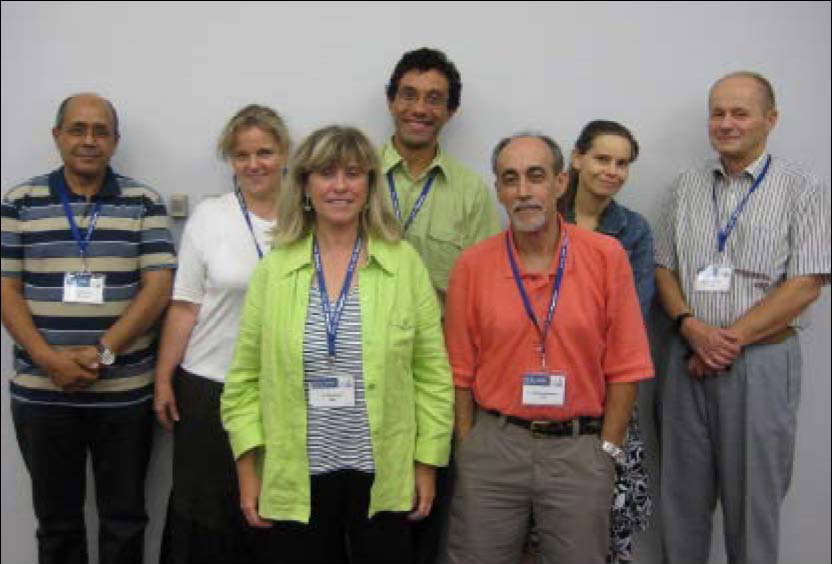


IUCr activities
An Inspiring new Commission: CrysAC*
 The members of the CrysAC Commission at the IUCr2008 Osaka meeting, during the first Open Meeting of the newly formed commission (courtesy of Prof. R. Gould, University of Edimburgh). From left to right: Abdelmalek Thalal, Alicja Rafalska-Lasocha, Simona Quartieri, Eric Dooryhée, Cele Abad-Zapatero, Anke Zürn, E. Makovicky (Gautam Desiraju is absent).
The members of the CrysAC Commission at the IUCr2008 Osaka meeting, during the first Open Meeting of the newly formed commission (courtesy of Prof. R. Gould, University of Edimburgh). From left to right: Abdelmalek Thalal, Alicja Rafalska-Lasocha, Simona Quartieri, Eric Dooryhée, Cele Abad-Zapatero, Anke Zürn, E. Makovicky (Gautam Desiraju is absent).
With those images in our eyes, we might have soon discovered the work of the pioneer Viennese graphic artist Koloman Moser [1](1868-1918) or the work of the better known Dutch graphic artist (M.C. Escher: 1898-1972) and his imaginative excursions into the tiling of the plane; to him it was like an obsession. His color plates and those of others (H. Hinterrreiter, 1902-1989) illustrated the concepts of polychromatic symmetry arguably before this notion appeared more widely in the literature. Moreover, Escher’s later works used his amazing artistry and richness in detail to depict imaginary self-reflecting worlds that were braided together with Gödel and Bach in that imaginative, tripartite golden braid written by Douglas Hofstadter entitled GEB (Godel, Escher, Bach) inviting all of us to reflect upon the unique threads of the human spirit, upon our own consciousness and who we are.
It is well documented that Escher got his inspiration to explore the tiling of the plane from the ceramic tiles that he saw in the magnificent palace of the Alhambra in Spain in 1936 during one of his trips to Andalusia. If this was a window of inspiration for him, it is also a source of study, analysis and exploration for an enlarging group of crystallographers and mathematicians exploring geometric patterns in Islamic art (see for instance www.castera.net). This field of study now encompasses Moorish zillij (tile) patterns including taqshir calligraphic patterns in the Alhambra and in many other places in the Islamic word: Blue Mosque in Istanbul, Kharraqan tomb towers in Iran, decorations at Mihrab, (the inner sanctum of the Islamic Mosques), among others. The maturity of this field of study is evident by the existence of an IUCr commission devoted to these topics (MaThCryst: www.crystallography.fr/mathcryst) and the multitude of papers that continue to appear on these topics ranging from the description of the decorations, to the detailed mathematical analysis and to the understanding of the artisanal and practical aspects of these artistic manifestations of the human spirit. A significant review of the current work in the field was presented at the satellite meeting of the European Crystallographic Society (ECM24) in Marrakech entitled The Enchanting Crystallography of Moroccan Ornaments, sponsored by the MaThCryst commission.
The study of symmetrical patterns in other human artifacts across different cultures such as Javanese Batik cloths, Pueblo Indian Pottery, Japanese feudal emblems (i.e., manji and kamon), Oriental carpets, Indian floor patterns (kolam) and others is an active area of research. The scope of these investigations is enormous and detailed studies might unveil unknown cross-pollination and influences between the different cultures in space and time; or it could reveal independent discovery of symmetrical patterns of decorations and motifs by the human mind (see bibliographies at www.crystallography.fr/crysac/bibliography.php and below).
What else is there besides the mathematical theory of ornamentation to attract crystallographers to art? What can the experimental methods related to crystallography add to the understanding of the relationship between Art and Crystallography or even more encompassing Art and Science? As noted by C.P. Snow, the schism between the two cultures became more significant in the 19th century but there is great impetus to bring these two critical threads of the human spirit together again and crystallography could provide a unique bridge and agglutinant. There is a tremendous amount of academic research on this theme with Art historians, artists, scientists and cultural observers all over the world taking sides on a continuous spectrum with two separate poles. Can the relationship between Art and Science be described by the nebulous concept of ‘spirit of the times’ (as embedded in the German word ‘Zeitgeist’), or is there a real causal link between Art and Science supported by concrete evidence? A large number of books (the most famous being probably the Shubnikov & Koptsik text on Symmetry in Science and Art) and research papers published in professional journals by the leaders in the field (see full article on the IUCr website) who present their individual work or review that of others and address this question in various ways. The range of studies is enormous and details can be found on the commission’s website or see www.leonardo.info/isast/spec.projects/artsciencebib.html for a non-exhaustive but annotated bibliography.
Crystallographic and related techniques (diffraction, spectroscopy, microanalysis and microimaging) applied to the microanalysis of samples (both crystalline and amorphous) originating from ancient paints, pottery, cosmetics, unguents, archaeological materials, preserving materials and many others can provide critical information on the composition, origin, production technology, authenticity, physical and cultural migration, historical development and other related issues. Thus, it can provide unambiguous evidence to Art scholars and historians, critics, archaeologists and anthropologists battling with questions that cannot be answered by more traditional methods. What branch of science or technology can claim such a wide range of ‘artistic’ leanings and applications with direct impact in the Art-Science interface?
In response to the growing interest and developments in the use of crystallographic methods to analyze historical, cultural and archaeological artifacts (among others) the Executive Committee of the IUCr at its meeting in Osaka (August 2008) approved the formation of a new commission appropriately named ‘Crystallography, Art and Cultural Heritage (CrysAC)’ devoted to the support and expansion of all of those lines of enquiry. The decision followed the request presented by E. Dooryhée (CNRS, France) who has been the leading force behind a proposal drafted by a group of crystallographer colleagues interested in this area of research [1]. The terms of governance, objectives and vision of this new commission as well as its current membership and group of supporting consultants can be found at www.crystallography.fr/crysac/. A satellite symposium organized jointly by the MaThCryst and CrysAC commissions will be held at the next meeting of the European Crystallographic Assn (ECM25) in Istanbul (Turkey, August 2009) devoted to the theme of Symmetry and Crystallography in Turkish Art and Culture. [2]
Any person interested in pursuing the scientific problems that this branch of crystallography is trying to address should always keep in mind three cardinal points as beacons to guide her or his interests in the areas of research that this commission seeks to explore at the interface of Art and Science. First, the analysis, explanations and insights into the artifacts/samples do not destroy the beauty and uniqueness of the objects under study no matter how aseptic the language of mineral names, textures, chemical formulae and space groups might sound. Second, the scientific and technological aspects represented and underlying in any form of Art (graphic, decorative, architectural or other) are a part of the cultural heritage of the societies and people of the Earth who created them. Finally, it is through the wise and intelligent usage of the findings, explanations and concepts expressed above that we can make our work and our discoveries more accessible to lay people so that the discoveries enrich their lives as much as they enrich ours; our findings can illuminate Art in unique ways for the specialist and for our fellow humans. We feel that the new commission created by the IUCr provides an inspiring opportunity to achieve all these goals in future years.
Visit the website of this new CrysAC commission of the IUCr (www.crystallography.fr/crysac/) or join the open mailing list at http://listes.uhp-nancy.fr/wws/info/crysac. We welcome your comments, suggestions and insight as to the goals, objectives, directions and strategies of this new commission to make this new initiative of the IUCr a complete success for all of us and for society at large.
Cele Abad-Zapatero on behalf of the members of the Commission on Crystallography, Art and Cultural Heritage of the IUCr*This is an abridged version of a full motivation essay that can be found at the commission’s website (www.crystallography.fr/crysac/motivation.php).
Notes
[1] During the Microsymposium Crystallography and Understanding of Cultural Heritage chaired by H. Schenk and S. Siano (XX Congress of IUCr, 2005, Florence), the concept of a new IUCr commission emerged. Eric Dooryhée, who presented a lecture – Powder diffraction in art and archaeology there and who had experience in the investigation of objects from art and archaeology, gave substance and body to the proposal with input from interested colleagues.
[2] www.crystallography.fr/mathcryst/istanbul2009.php


